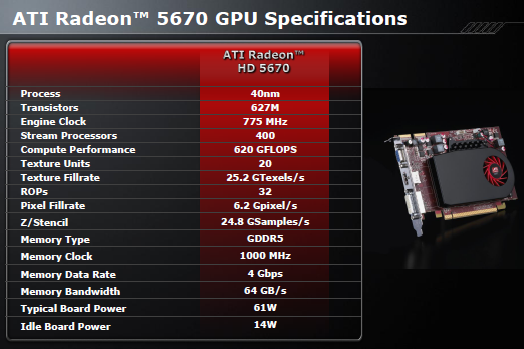Talking Numbers
Half a HD 5770?Leaving clock-speeds aside for a second, it's not quite half a HD 5770, because AMD uses the same 128-bit memory-interface as on HD 5770, along with GDDR5 memory that helps keep bandwidth reasonably high. What this means is that the HD 5670 should have commensurately more bandwidth to feed its ROPs, leading, we conjecture, to decent AA and AF performance as resolution and image quality is dialled up.

The AMD-supplied slide is incorrect as it states the card has 32 ROPs instead of eight. The general frequencies are what we'd expect from a £70-plus card, and, looking at the numbers, performance should be very competitive with the NVIDIA GeForce GT 240 and in the same ballpark as the GTS 250.
5-series multimedia and power credentials intact
Continuing the power-efficient theme of DX11 line-up, the card is reckoned to draw 61W under load and just 14W when idling.
The card also carries the Eyefinity multi-monitor support, albeit rather limited with due appreciation of the price-point. We like the fact that the pass-through audio features bit-stream support for TrueHD and DTS-HD Master Audio, as well as 8-channel LPCM.
Summary
There are no surprises with the Radeon HD 5670. Representing a little more than half of a Radeon HD 5700-series card, the architecture is clearly designed to hit a price-point sweetspot.
Partners will retail two versions, differentiated by framebuffer above all else. Expect to pay £70 for a 512MB-equipped card and a £15-£20 premium for a card outfitted with a 1,024MB framebuffer and better display connectivity.









